Polish house prices continue to rise strongly
Poland’s housing market remains strong, due to the country’s excellent economic performance, wage rises and declining unemployment, combined with historic low interest rates.
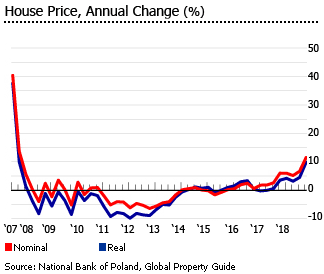
The average price of existing flats in Poland’s 7 big cities (Warsaw, Gdańsk, Gdynia, Kraków, Łódź, Poznań, and Wrocław) increased by 7.11% (5.51% inflation-adjusted) during 2018 to an average of PLN 6,905 (€ 1,605) per square metre (sq. m.), from y-o-y rises of 7.87% in 2017, 2.64% in 2016, 1.1% in 2015, and 1.69% in 2014, according to the Polish central bank, Narodowy Bank Polski (NBP). On a quarterly basis, house prices were up by 2% (1.5% inflation-adjusted) in Q4 2018.
- In Warsaw the average price of existing houses rose by 11.52% (9.86% inflation-adjusted) during 2018.
- Gdańsk saw the highest house price rise among Poland’s seven major cities, with a 20.56% (18.77% inflation-adjusted) y-o-y price surge in 2018. It was followed by Gdynia with a 15.43% y-o-y increase.
- Other Polish major cities also enjoyed high price hikes, including Łódź (11.52%), Kraków (11.49%), and Poznań (9.11%).
- Among the 7 big cities, Wrocław saw the lowest price hike of 3.23% (1.69% inflation-adjusted) during 2018.
Warsaw has Poland’s most expensive housing, with an average selling price of PLN 10,300 (€ 2,394) per sq. m. in 2018, according to NBP. Housing is also expensive in Gdańsk, with an average price of PLN 8,855 (€ 2,058) per sq. m., Gdynia with PLN 8,523 (€ 1,981) per sq. m. and Kraków with PLN 8,466 (€ 1,968) per sq. m.
Łódź had the cheapest houses among the 7 big cities, with an average price of PLN 4,811 (€ 1,118) per sq. m.
The strong price rises are mainly due to robust demand, supply shortages and higher construction costs, as well as a declining share of low-cost "Housing the Young" (MdM) scheme units, after the programme closed in January 2018.
In 2018, the total number of new flats sold in the country’s six major cities fell by 12.3% to 64,800 units from a year earlier, according to REAS JLL Residential Advisory. Despite this, last year’s sales level remains the second highest in the market’s history.
“Although 2018 was far from achieving the record-breaking results of 2017, it was a very good year in terms of the number of sold flats – slightly better than in 2016, making it the second-best year in the history of the residential development market in Poland,” said REAS.
Foreigners can freely buy condominium units in Poland. Land for commercial purposes can be freely bought by citizens of the European Economic Area (EU + Iceland, Liechtenstein, and Norway).
The Polish economy grew by a robust 5.1% in 2018, up from the previous year’s 4.8% expansion and the highest growth since 2007. The International Monetary Fund (IMF) expects the economy to expand by 3.8% this year while the World Bank is more optimistic with a 4% growth projection – amidst a slowdown in the euro zone, Poland’s biggest trade partner.
Poland had one of Europe’s biggest booms - but its bust was not so big
House prices in the country’s major cities are now back to their pre-crisis peaks of 2008. The average price of existing flats in Poland’s 7 big cities was up slightly by 0.2% in 2018 compared to a decade ago.
- In Gdańsk, house prices are now up by 30.4% compared to 2008
- In Krakow, house prices are up 16.8%
- In Łódź, house prices are still down by 1.3%
- In Warsaw, house prices are up 1%
- In Poznań, house prices are up 16.4%
- In Gdynia, house prices are up 20.7%
- In Wrocław, house prices are down 4.2%
Surprisingly, Poland’s bust was remarkably small, given the amazing scale of its housing boom from 2004 to 2007 which was fuelled by an inflow of investment due to the country’s accession to the EU, record low interest rates, and mortgage finance development.
Property prices surged in Warsaw during the boom - rising 23% in 2005, 28% in 2006, an amazing 45% in 2007, and 13% in 2008, according to REAS. Other cities such as Wroclaw saw even larger house price rises.

Behind the boom lay strong economic growth.
However during the 2008-09 crisis the Polish zloty fell dramatically, and mortgages - mainly denominated in foreign currencies - became unrepayable.
Home prices fell for 6 straight years. House prices in Poland’s 7 major cities dropped 13.8% (-25.3% inflation-adjusted) from 2008 to 2013. Prices started to rise again in 2014, and has been on a rising trend since then.
Demand remains robust
In 2018, the total number of new flats sold in the country’s six major cities fell by 12.3% to 64,800 units from a year earlier, amidst a decline in the number of private investors buying flats to let, according to REAS JLL Residential Advisory’s Q4 2018 report. Despite the decline, last year’s sales level remains the second highest in the market’s history.
Among Poland’s major cities:
- Tri-City recorded the biggest sales decline of 16% in 2018 from a year earlier
- Sales transactions were down by 15% y-o-y in 2018 in both Warsaw and Wrocław
- In Kraków, sales dropped 10% y-o-y in 2018
- In Poznań, sales were almost unchanged in 2018
- Among Poland’s major cities, only Łódź recorded sales growth of 29.6% during 2018
In Q1 2019, sales transactions totaled 16,500 units, almost unchanged from the previous quarter. On the other hand, there were 16,800 new flats launched for sale in Q1 2019.
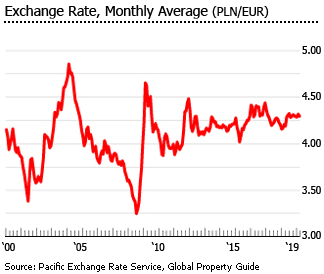
“Demand for flats remain high, but less availability of mortgages (The Home for the Young scheme coming to an end) and dissatisfaction with erratic increases in prices could cause buyers to put decisions about purchases on hold,” said REAS JLL Residential Advisory. “This group consists of people buying for cash and private investors buying flats to let.”
The Mieszkanie dla Mlodych (MdM) program (popularly known as the Home for the Young scheme) which buoyed demand for cheap flats in recent years, has now practically come to an end, as funds for government subsidies have run out. This led to a decline in the number of sales transactions in the low-income market segment.
Increasing residential construction activity
Despite the end of the Home for the Young scheme, residential construction is actually rising. In 2018, the number of dwelling permits granted rose by 3.3% y-o-y to 251,030 units, according to the Central Statistical Office of Poland. Likewise, the useful floor area of new residential building permits granted also increased 4.6% to 23.44 million sq. m. in 2018 from a year earlier.
During 2018:
- Dwelling starts: 221,907 units, up 7.7% from a year earlier
- Dwelling completions: 185,170 units, up 3.8% from a year ago
In 2018, around 35.8% of newly-completed dwellings were built by private investors. Developers built about 60.7% while housing cooperatives accounted for just around 1.6% of the total dwelling completions.
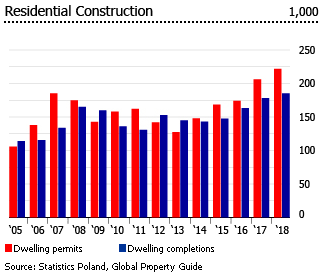
The Polish residential market lags behind Western European countries in terms of quality, age of stock, and level of market saturation, according to Ernst and Young. Of the 13.85 million residential units in Poland, around 72% were built before 1989, mostly during the communist era using prefabricated technology, which tends to be of very poor quality.
Modern units built from 2000 onwards comprise only about 12% of the total and are concentrated primarily in six areas: Warsaw, Krakow, Poznan, Wroclaw, Tricity, and Lodz.
Poland’s housing supply constraint is “mainly administration-driven and consists of the limited number of zoning plans, covering below 30% of country’s area”, according to a report by Ernst and Young. The lack of zoning plans leads to administrative procedures to take from a few months to a year to resolve.
Good rental yields in Warsaw and Krakow; renters plentiful
Gross rental yields in Warsaw range from 5.50% to 6.75%. In Krakow, rental yields range from 5.66% to 6.47%, based on Global Property Guide research.
The Warsaw district of Mokotow, located just below Srodmiescie, houses many foreign embassies and companies. A 120 sq. m. apartment in Mokotow offers rental yields averaging 6.61%.
Apartments in Srodmiescie, which includes the historic neighborhoods of the Old Town (Stare Miasto) and the New Town (Nowe Miasto), offer gross rental yields ranging from 5.50% to 6.75%.
In the other popular Warsaw areas, Wilanów and Żoliborz, apartments offer good rental returns ranging from 5.82% to 6.38%.
Despite attractive rental yields, the big downside is that round trip transaction costs are high in Poland.
Renting is an unavoidable choice for more and more Poles, as stricter requirements for mortgage financing, uncertainty in the labour market, and low growth prospects, all discourage households from incurring long-term debts. The movement of people from other cities to the capital, especially students or young people looking for work, also drives people to rent.
About 21% of households in Warsaw rent apartments, with half of these in social and communal housing. Most residential properties in Poland are owned by private individuals.
About 10.7% of the dwelling stock is rented at lower rates, with 5.7% in communal or social housing, 2.1% in cooperative tenancy, 1.2% in state-owned companies, 1.2% the State Treasury, and 0.5% in public building societies, according to the 2011 National Census. The remaining dwelling stock is primarily owner-occupied.
Key rate still at record low
The average interest rate for PLN-denominated outstanding housing loans was 3.82% in February 2019, almost unchanged from last year’s 3.8%, according to the NBP. Over the same period:
- For outstanding housing loans with maturity between 1 year and 5 years the interest rate was 4.19% in February 2019, down from 5.53% a year ago.
- For housing loans with maturity of over 5 years the interest rate was 3.8%, almost unchanged from the previous year’s 3.79%.
For PLN-denominated new housing loans, the average interest rate stood at 4.35% in February 2019, down from 4.42% a year earlier.
Likewise, the average interest rate for EUR-denominated new housing loans dropped to 3.6%, from 4% a year ago.
In April 2019, the central bank’s key rate was kept at a record low of 1.5%, as the country’s inflation rate remains well below its target of 2.5%. Also, the Lombard rate and the deposit rate were kept unchanged, at 2.5% and 0.5%, respectively, and the rediscount rate was left at 1.75%.
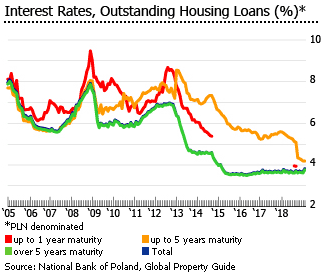
“In the Council´s assessment, the outlook for economic conditions in Poland remains favourable. However, in the quarters to come, there will probably be a gradual slowdown in GDP growth. At the same time, inflation will remain at a moderate level and, in the monetary policy transmission horizon, will stay close to the target,” said the country’s Monetary Policy Council in its April 2019 meeting.
“The Council judges that the current level of interest rates is conducive to keeping the Polish economy on a sustainable growth path and maintaining macroeconomic stability.”
Mortgage market has been growing
The Polish mortgage market grew from only 1.3% of GDP in 2000 to 9.9% of GDP in 2007, and to almost 20% of GDP in 2018. In March 2019, Poland’s total outstanding housing loans rose by 7.1% to PLN 421.11 billion (EUR 98.24 billion) from the same period last year, according to the NBP.
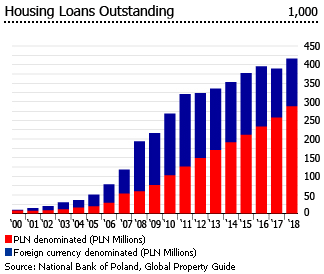
In March 2019:
- Zloty-denominated housing loans outstanding rose by 11.5% y-o-y to PLN 294.8 billion (EUR 68.77 billion).
- Foreign currency-denominated housing loans fell by 2% y-o-y to PLN 126.31 billion (EUR 29.47 billion).
The proportion of foreign currency-denominated housing loans (including Swiss franc loans) peaked at more than 69% in 2008, causing a crisis when the currency collapsed. However the proportion has since declined and was around 31% in 2018, according to NBP.
MdM (“Housing the Young”) program is out; National Housing Program is in
The final PLN 381 million (€ 88.88 million) of subsidies under the Mieszkanie dla Mlodych (MdM) program was approved in January 2018, marking the end of this scheme.
MdM was a housing subsidy program introduced by the government in early 2014, aimed at helping young people aged up to 35 (either single or married) buy their first new flat. Effectively the program gave a 10% subsidy to childless families and singles and a 15% subsidy to families with children and single parents. Another 5% subsidy was granted to families with three or more children. However, the program placed caps on both apartment size and price per square metre. In the case of house construction, the subsidy came in the shape of partial VAT return on building materials used.
The Law and Justice Party (PiS)-led government has replaced the MdM scheme by the "National Housing Program" which began at the end of 2016. This includes the construction of affordable housing units for rent and giving renters a purchase option. The new program intends to redirect public funds toward social groups with significantly lower incomes, and away from middle-income groups that were previously supported by other housing programs.
The construction of new apartment buildings under the program began in 2018. Rent will be around PLN 10 (€2.3) to PLN 20 (€4.7) per sq. m.
Based on government estimates, about 40% of people in Poland, a nation of 38 million people, cannot even afford to rent an apartment.
Robust economic performance; record-low unemployment
The Polish economy grew by a robust 5.1% in 2018 from a year earlier, up from the previous year’s 4.8% expansion and the highest growth since 2007. Growth was supported by robust domestic demand and recovering investments.
Economic growth is expected to slow to 4% this year, amidst a slowdown in the euro zone, Poland’s biggest trade partner, based on World Bank estimates. Yet it is still far higher compared to the euro zone’s projected growth for 2019 of 1.6%.
“The Polish economy is still growing at a rate significantly above the EU average,” said Carlos Piñerúa of World Bank. “The low unemployment rate and strong wage growth are still driving private consumption; investments, both public and private, are growing too.”
Poland, which does not use the euro, is the only European country that avoided recession during the global financial and economic meltdown. The Polish economy expanded by 4.3% in 2008, 2.8% in 2009, 3.6% in 2010 and 5% in 2011, according to the IMF. However growth slowed in 2012 and 2013, with GDP growth rates of just 1.6% and 1.4% respectively, due to the recession in the Eurozone, which accounts for over 50% of Polish exports.
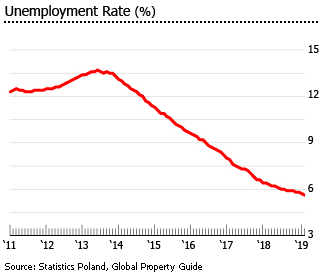
The Polish economy bounced back in 2014 with 3.3% growth, fueled mainly by strong domestic demand. Economic expansion continued in 2015 and 2016, posting growth rates of 3.8% and 3%, respectively.
Poland’s budget deficit stood at 0.4% of GDP in 2018, down from the previous year’s 1.4% shortfall and the lowest level since the beginning of Poland’s data collection in 1995, according to Statistics Poland. The country’s budget deficit is projected to increase to 1.4% of GDP this year and to 1.6% of GDP in 2020.
The government debt was trimmed to 48.9% of GDP in 2018, from 50.6% of GDP in 2017, 54.2% in 2016 and 51.3% in 2015.
Annual inflation stood at 1.7% in March 2019, up from 1.2% in February and 0.9% in January. Inflation is expected to accelerate to 2.3% this year and to 2.7% in 2020, from an annual average of 0.5% from 2013 to 2018, according to the European Commission.
In March 2019, Poland’s unemployment rate hit a 29-year low at 5.6%, down from last year’s 6.3%, according to Statistics Poland. Over the same period, there were about 933,200 unemployed people in the country, down from 1,034,600 a year earlier.
Tension with EU raises political uncertainty
In contrast to Poland’s booming economic performance, its political situation is clouded due to the growing strain between the country and the European Union (EU). In December 2017, the EU recommended launching an unprecedented disciplinary process against the Polish government due to the latter’s judicial reforms, which the EU calls a "clear risk of a serious breach of the rule of law". The said reforms effectively put the Supreme Court under the control of the governing party.
The conflict has been brewing since the populist Law and Justice Party (PiS) candidate Andrzej Duda won the presidential elections in May 2015 and the PiS party won the majority of seats in November 2015.
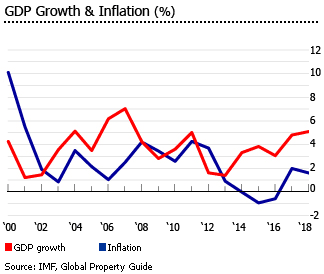
In 2017, the EU took the first steps toward stripping the country of its voting rights – a penalty that has never been used against any member nation.
Poland, the biggest beneficiary of the EU funds, may also see its funds cut in the new 2021-2027 EU budget.
Despite this, Poland continued with its "reforms", formally introducing a law in July 2018 that lowers the retirement age for judges from 70 to 65. This triggered widespread street protests after more than 20 judges (about a third of the total) were forced to retire.
This caused the EU to issue a ruling that obliges Poland to suspend the law immediately. Giving in to pressure, Duda finally reversed the law in December 2018, effectively reinstating the judges forced into early retirement – a surprising move after months Poland’s top officials saying they would resist any move to stop the judicial reforms.
“We are members of the European Union and we will abide by European Union law,” said PiS head Jaroslaw Kaczynski.
Poland’s concession of the Supreme Court is not a guarantee that the conflict between the PiS-led government and the EU has finally ended, but it represented a positive development.
homes for sale in poland, poland homes for sale, homes for sale in poland maine, homes for sale in warsaw poland, zillow, zillow.com, zillow for sale, zilow, zillo, homes for sale near me, zillow rental, hamilton may, dom pod wilgą, hamilton may kraków, nieruchomości kraków, dom pod wilga, garden residence, apartamenty novum, riverside kraków, angel wawel, browar lubicz, novum kraków, apartamenty przy bulwarze, browar lubicz mieszkania, hamilton may krakow, harmonica house, małe błonia kraków, parkowe wzgórze, rakowicka podkowa, angel wawel ceny, dom pod wilgą ceny, domy kraków, wiślane tarasy, luksusowe domy, krakow real estate, parkowe wzgórze mogilany, kazimierz kraków, lea residence, rent a flat in krakow, krakow apartments for rent, apartamenty kraków sprzedaż, krakow apartments for sale, wiślane tarasy wynajem, podkowa rakowicka, kraków kazimierz, lofty kraków, equal business park, nieruchomosci krakow, riverside krakow, hamiltonmay, property krakow, tarasy verona, apartamenty kraków wynajem, fabryka czekolady kraków, wynajem powierzchni biurowych kraków, angel wawel cena, drukarnia narodowa, angel wawel krakow, nadwiślańska 5, apartamenty ludwinów, domy na sprzedaż kraków, apartamenty wola justowska, angel city kraków, osiedle riverside, augustiańska residence, garden residence kraków, dom na wynajem, apartamenty ludwinow, wiślane tarasy kraków, apartamenty novum kraków, loft kraków, powierzchnie biurowe kraków, salwator tower, kraków apartamenty na sprzedaż, mogilany parkowe wzgórze, angelwawel, dom na sprzedaż kraków, novum apartamenty, nadwiślańska 11, apartamenty z ogrodu, kossak residence, angel wawel kraków, ludwinów, apartamenty na sprzedaż kraków, wislane tarasy, novum krakow, isk krakow, cystersów garden, pod wilga, penthouses, domy na wynajem, magnoliowy ogród, hamernia 29, kazimierz krakow, salwator, tarasy wiślane, wola justowska kraków, domy do wynajęcia kraków, garden residence wynajem, river lane, zamoyskiego 30, wawrzyńca 21, nadwiślańska 5 kraków, future city, dom pod wilgą kraków, parkowe wzgorze, czarodziejska, tanie domy na sprzedaż okolice krakowa, cystersow garden, czarodziejska kraków, house rentals, angel plaza, wawrzynca 21, hortus apartments, lublańska park, garden lane kraków, masarska 8, wola justowska mieszkania, lofty krakow, willa rudawa, novum rakowicka, apartamenty w krakowie wynajem, perla verona, kraków apartamenty, angel plaza kraków, dompodwilga, kraków domy na sprzedaż, tarasy verona kraków, riverside osiedle, kaskada kraków, angel city, mieszkania kraków centrum, garden residence krakow, angel stradom, hamilton may warsaw, atal residence zabłocie, przy bulwarze, domy pod krakowem, kamienice wandy, loft krakow, mieszkania wola justowska, pasaż podgórski, domy okolice krakowa, real estate kraków, osiedle parkowe wzgórze, mieszkania browar lubicz, house rent, podgórze kraków, plac na groblach, apartamenty stary browar kraków, apartamenty przy bulwarze kraków, venetian house aparthotel, apartamenty sowiniec, nadwislanska 5, kraków fabryka czekolady, wynajem powierzchni biurowych, ludwinów kraków, apartamenty kaskada, nadwislanska 11, domy na sprzedaz krakow, wola justowska, nowy przewóz, kraków stare miasto, luksusowe apartamenty kraków, nowy przewoz, apartamenty czarodziejska, piękne domy na sprzedaż, mieszkaj w mieście, fabryka czekolady krakow, mieszkania kraków wola justowska, kraków apartamenty sprzedaż, hamilton may opinie, wiślane tarasy sprzedam, czarodziejska apartamenty, apartamenty kaskada kraków, river lane kraków, pasaz podgorski, zabłocie inwestycje, angel kraków, pasaz podgórski, małe błonia, dom na sprzedaz krakow, wynajem domu kraków, angel krakow, loft kraków wynajem, isk kraków, apartamenty na wynajem kraków, axis kraków, apartamenty rakowicka, tarasy wislane, apartments in krakow, wiślane tarasy 2, angel city krakow, enterprise park kraków, mieszkanie dwupokojowe, kraków dom na sprzedaż, property to rent, apartamenty lubicz kraków, mieszkanie wola justowska, houses for sale in poland, house for rent, apartamenty morelove, domy na sprzedaż kraków i okolice, piannisimo, future city kraków, apartament kraków sprzedaż, kaskada krakow, 4 sale, zillow mortgage calculator, houses for rent near me, apartments near me, mortgage calculator, houses for rent, zillow nj, houses for sale near me, houses for sale, homes for sale, craigslist nh, www.zillow.com, zilllow, zwillow, apartments for rent, real estate, zillow florida, zillow san diego, zilloq, for sale by owner, zestimate, zillow denver, zillow pa, zillow seattle, how much mortgage can i afford, zillow tucson, zillow rentals, house for sale, zillow maine, zillow oregon, zillow ct, zillow las vegas, zillow ma, craigslist yuma, zillow spokane, zillow chicago, zilloe, zillow ca, homes for rent, zillow for rent, apartments for rent near me, zillow mi, zillow ohio, zillow ri, manufactured homes, zilliow, trulia.com, zillow colorado, land for sale near me, zillow fl, zillow utah, zillow md, zillow ga, zillow tulsa, zillow ny, zillows, zillow rental manager, zillow portland, how much is my house worth, zillow rent, utah real estate, homes for rent near me, zillow mn, zillow home values, zillow nc, zillow nh, rent, san francisco zillow, house for rent, zillow austin, zillow miami, trulia, zillow boise, mortgage calculator zillow, what is my house worth, zillow atlanta, zillow reno, zillow vt, craigs, zillow houston, zillow phoenix, zillow zestimate, www.zillow.com/homes for sale, zillow az, zillow va, zillow omaha, illow, zillow colorado springs, condos for sale, zillow los angeles, zillow orlando, zillow san antonio, zillow dallas, zillow tampa, rentals near me, zollow, zellow, house for rent near me, fsbo, zillow,com, zillow texas, how much rent can i afford, apartment for rent, rent to own, zillow san francisco, craigslist okaloosa, zillow login, zillow st. louis, zillow home value, zillow homes for sale, zillw, ziloow, zillow idaho, rent calculator, mobile homes for sale, zillow bend, zillow naples fl, apartment finder, mobile homes for rent, zillow pensacola, zillow midland tx, zillow michigan, zillow nashville, zillow lincoln ne, rental homes, homes for sale indiana, zillow eugene, maine real estate, zillow madison wi, zillow wilmington nc, what is my home worth, house for sale near me, realestate, zillow albuquerque, zillow gainesville fl, homes for sale in maine, zillow calculator, homes for sale in trussville al, what´s my house worth, home for sale, zillow anchorage, zilloow, reece and nichols, places for rent near me, chicago apartments, townhomes for rent, rentals, zillow charleston sc, zillow sc, zillow santa fe, for rent, zillow okc, zllow, how much is my home worth, sioux falls real estate, zillow idaho falls, www.zillow, zillow minneapolis, zillow sacramento, kentucky homes for sale, real estate websites, zillow missoula, steps to buying a house, houses for sale in oroville ca, zillow fort collins, zillow api, homes, seattle apartments, zillow dc, zillow wi, zillow santa cruz, zillow real estate, zillowcom, zillow pittsburgh, atlanta real estate, montana real estate, homes for sale by owner, zillow jacksonville fl, zillow boston, zillow.xom, zillow charlotte nc, zillow indiana, zillow sarasota, what´s my home worth, forsalebyowner, zillow santa barbara, zillow san jose, zillow richmond va, home value, zillow salem oregon, san antonio homes for sale, zillow., zillow .com, okaloosa craigslist
Sources:
- Real Estate Market – Quarterly Information (Narodowy Bank Polski): https://www.nbp.pl/home.aspx?f=/publikacje/rynek_nieruchomosci/index2.html
- Construction (Statistics Poland): http://swaid.stat.gov.pl/en/SitePagesDBW/Budownictwo.aspx
- World Economic Outlook Database (International Monetary Fund): https://www.imf.org/external/pubs/ft/weo/2019/01/weodata/index.aspx
- MIR Statistics (Narodowy Bank Polski): http://www.nbp.pl/homen.aspx?f=/en/statystyka/oproc/oproc.html
- Monetary and Financial Statistics (Narodowy Bank Polski): http://www.nbp.pl/homen.aspx?f=/en/statystyka/zobowiazania.html
- Poland interest rate (Trading Economics): https://tradingeconomics.com/poland/interest-rate
- Interest rates (Narodowy Bank Polski): http://www.nbp.pl/homen.aspx?f=/en/dzienne/stopy.htm
- Information from the meeting of the Monetary Policy Council held on 2-3 April 2019 (Narodowy Bank Polski): https://www.nbp.pl/en/aktualnosci/2019/mpc_2019_04_03.pdf
- Yields in Warsaw and Krakow are good, at around 6% (Global Property Guide): https://www.globalpropertyguide.com/Europe/Poland/Rental-Yields
- Developers still doing well (REAS JLL Residential Advisory): http://www.reas.pl/en/commentaries/developers-still-doing-well
- Summary of 2018 on the primary residential market (REAS JLL Residential Advisory): http://www.reas.pl/en/commentaries/summary-of-2018-on-the-primary-residential-market
- Poland launches cheap housing program for families (Business Insider): https://www.businessinsider.com/ap-poland-launches-cheap-housing-program-for-families-2016-6
- Polish Economy to Slow Slightly, Fiscal Deficit to Grow (Modern Diplomacy): https://moderndiplomacy.eu/2019/04/08/polish-economy-to-slow-slightly-fiscal-deficit-to-grow/
- Poland Government Budget (Trading Economics): https://tradingeconomics.com/poland/government-budget
- Poland Government Debt to GDP (Trading Economics): https://tradingeconomics.com/poland/government-debt-to-gdp
- Economic forecast for Poland (European Commission): https://ec.europa.eu/info/business-economy-euro/economic-performance-and-forecasts/economic-performance-country/poland/economic-forecast-poland_en
- Poland Reverses Supreme Court Purge, Retreating From Conflict With E.U. (New York Times): https://www.nytimes.com/2018/12/17/world/europe/poland-supreme-court.html
- Poland reinstates Supreme Court judges following EU ruling (BBC News): https://www.bbc.com/news/world-europe-46600425